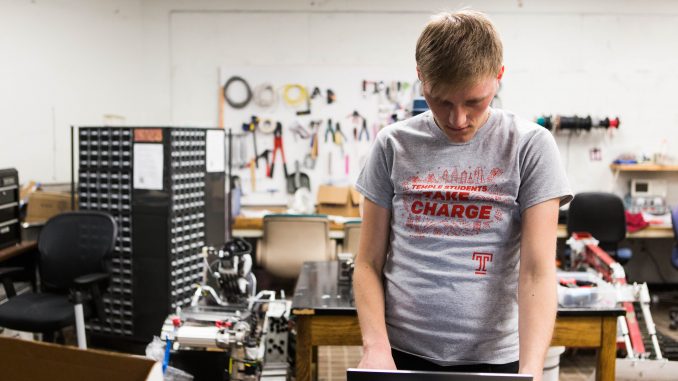
For a team of engineers at Temple, tomorrow’s solar eclipse is a once-in-a-lifetime opportunity — but instead of watching it from the ground like many others, they’ll be capturing it with a camera drifting miles above their heads.
“We’re aiming for success,” said Dmitry Yarmaliuk, one of four 2017 alumni planning to livestream the eclipse in Russellville, Kentucky, where complete darkness will last longer than most parts of the country.
Before graduating, the four students constructed the project for Senior Design, a series of capstone courses in the College of Engineering.
Now, the engineers are participants in the nationwide Eclipse Ballooning Project.
The initiative, funded by NASA, allowed 55 student groups — including one at Temple — to gather live, digital documentation for the public to access online.
As Monday unfolds, dozens of engineers like Yarmaliuk will film the moon as it passes over the sun — causing darkness to shroud daylight in the middle of the afternoon.
The last solar eclipse visible to the United States happened in 1979, years before a livestream was even possible.
“It’s never been done before,” said alumna and engineer Abby Sydnes as she packed for the trek to Kentucky.
Before embarking on the 10-hour drive, the team stocked a van with supplies they will need: a parachute, helium regulators, motors and heaps of duct tape.
Filming an eclipse is no simple task.
During their last three semesters at Temple, Yarmaliuk and Sydnes worked alongside Edward MacMurchy and Michael Mazzanti. Together, the four engineering students crafted a payload, a system meant to support the camera that films the eclipse.
The goal is smooth, continuous footage of the eclipse — all while the camera floats in a latex balloon that could reach up to 100,000 feet above the ground.
“I’m not going to say, ‘Oh, you know, it was easy,’” said Yarmaliuk, the team’s software engineer. “It was not. It was challenging, it was stressful at moments, but it’s definitely rewarding.”
For John Helferty, a professor in the College of Engineering, taking on the project was a “no-brainer.”
“When else would you get a chance to make history?” he said.
Helferty, a 1983 alumnus himself, spent years studying rocketry and high-altitude ballooning. After working at NASA’s Jet Propulsion Lab, he returned to Temple with funding for the Student Space Exploration and Environmental Systems Laboratory — a center that allows students to pursue special projects involving ballooning, drones and robotics.
Before the spring 2016 semester, Helferty proposed the project — and the three-semester commitment along with it. Before long, Yarmaliuk, Sydnes, MacMurchy and Mazzanti began designing.
“I didn’t have to really sell it to them, I described it to them and they were like, ‘Let’s do it,’” Helferty said.
Their carefully crafted payload system brought the students closer to graduation — and won the College of Engineering’s Senior Design contest for 2017.
But the project wasn’t done, and after graduation, the engineers began working full-time. Some moved out of Pennsylvania.
Despite the complications, they all agreed to travel to Kentucky in August to launch their payload, film the eclipse and finish the project.
“This is something that you, when you commit, you can’t back out of,” Helferty said.
In June, after the team had finished the project and graduated, NASA began changing its streaming software. The updates continued into early August, forcing the team to make last-minute adjustments to the payload.
“I have a team today that’s modifying software in a van, going from Pennsylvania to Kentucky!” Helferty said Saturday morning.
Still, Helferty said he remains confident.
“These guys are some of the best software engineers I’ve ever seen,” he added.
Many teams Helferty said, will depend on an autonomous system: switching between multiple cameras as the cameras detect the sun’s presence. The result could produce a jumpy, discontinuous video.
Instead, Temple’s team developed its own manual control system.
“It’s like having an autonomous car. You want somebody at the wheel, you know what I mean?” Helferty said.
By clicking the keys on his laptop, Yarmaliuk will be able to swivel a single camera as it ascends into the atmosphere.
“I literally got that idea to do that like sitting at home Friday night, and I’m like, ‘Man, maybe I should do this just in case,’” Yamaliuk said.
As the project nears to an end, both Yarmaliuk and Sydnes expect relief.
“We’ve been working on this for so long,” Sydnes said. “So, it’ll be nice to finally see all the work that we did for the last year and a half actually come out to something useful for somebody.”
The team worked to predict and prevent failures from occurring during the launch. But, Yarmaliuk said, there are factors in the air that no one can control.
Still, Yarmaliuk said the hours of engineering will be worth it.
“The scope of this project, I mean not a lot of people can say, ‘I launched a balloon up into space,’” he said.


Be the first to comment